Module3 On the radio Unit2 I remember sitting close to the radio
- 格式:doc
- 大小:33.50 KB
- 文档页数:2
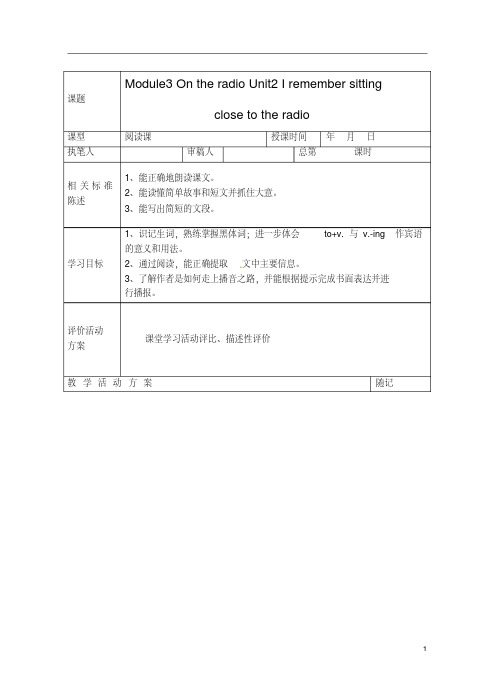
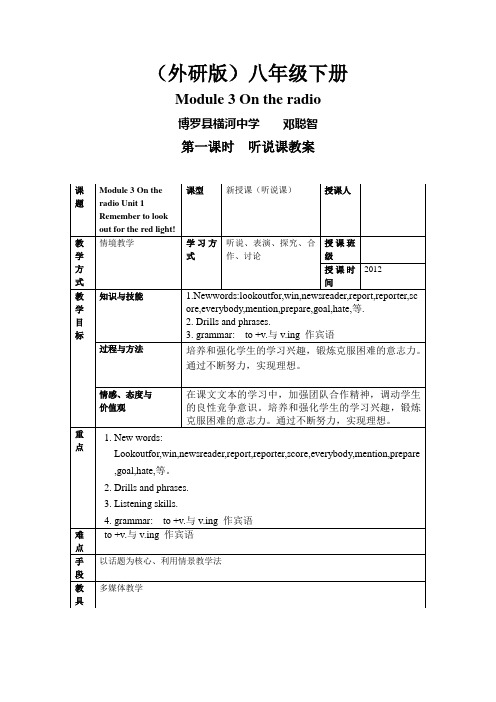
(外研版)八年级下册Module 3 On the radio博罗县横河中学邓聪智第一课时听说课教案第二课时读写课教案第三课时语法课教案教学过程Warm-up 教师活动Step 1: Warming up1.Ask the Ss to retell the text in Unit2.2.Ask the Ss “How to get a job on the radio?” and let them todiscuss in groups and present their answers.课题Module 3 On theradio Unit 3Language in use.课型新授课(听说课)授课人教学方式归纳总结、综合运用学习方式听说、写作、操练、合作、讨论授课班级授课时间2012教学目标知识与技能掌握动词后接动词不定式和动名词的形式;继续复习宾语从句过程与方法理解动词后接不定式和动名词的形式并能运用这些知识进行交流和沟通。
情感、态度与价值观培养和强化学生的学习兴趣,锻炼克服困难的意志力。
通过不断努力,实现理想。
重点动词后接动词不定式和动名词的形式难点不定式和动名词的区别及用法手段利用情景教学法、写作、展示教具多媒体教学学生活动1.Try to retell the text.2.Discuss in groups and show the answers in front of the class.目的复述短文,复习旧知识,联系生活实际,运用学过的知识解决实际问题。
Lead in 教师活动Step 2: Reading and thinking1.What’s your favurite radio programme?2.Have you heard of the Clockwork Radio?3.Where was the Clockwork Radio?4.When did the Clockwork Radio make?学生活动Read Around the world and answer the questions目的联系学生的生活实际和爱好,学习Around the world,了解世界上各种有趣新鲜的事物,让他们阅读,充分调动学生的积极性,发挥他们的主体性,让他们在学习中生活,在生活中学习,了解并吸收外来文化。
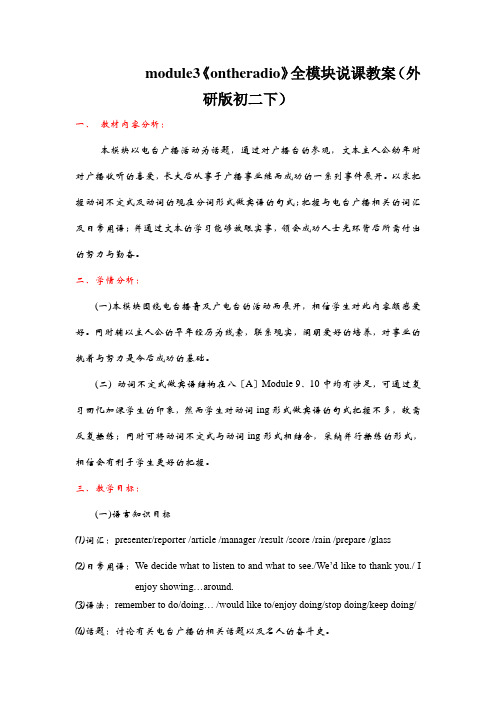
module3《ontheradio》全模块说课教案(外研版初二下)一、教材内容分析:本模块以电台广播活动为话题,通过对广播台的参观,文本主人公幼年时对广播收听的喜爱,长大后从事于广播事业继而成功的一系列事件展开。
以求把握动词不定式及动词的现在分词形式做宾语的句式;把握与电台广播相关的词汇及日常用语;并通过文本的学习能够放眼实事,领会成功人士光环背后所需付出的努力与勤奋。
二、学情分析:(一)本模块围绕电台播音及广电台的活动而展开,相信学生对此内容颇感爱好。
同时辅以主人公的早年经历为线索,联系现实,阐明爱好的培养,对事业的执着与努力是今后成功的基础。
(二) 动词不定式做宾语结构在八〔A〕Module 9、10中均有涉足,可通过复习回忆加深学生的印象,然而学生对动词ing形式做宾语的句式把握不多,故需反复操练;同时可将动词不定式与动词ing形式相结合,采纳并行操练的形式,相信会有利于学生更好的把握。
三、教学目标:(一)语言知识目标⑴词汇:presenter/reporter /article /manager /result /score /rain /prepare /glass⑵日常用语:We decide what to listen to and what to see./We’d like to thank you./ Ienjoy showing…around.⑶语法:remember to do/doing… /would like to/enjoy doing/stop doing/keep doing/⑷话题:讨论有关电台广播的相关话题以及名人的奋斗史。
(二)语言技能目标⑴听:熟练明白得文本内容,并能通过课文听讲训练,明白得简单的英语广播播报。
⑵讲:通过课文文本的学习,辅以咨询答及讨论的形式反复操练,学会复述课文,并能简单讲述某名人的奋斗史。
⑶读:提高泛读能力,把握文本精华。
⑷写:撰写自我感爱好的广播稿或撰写当前媒体名人的早年经历。
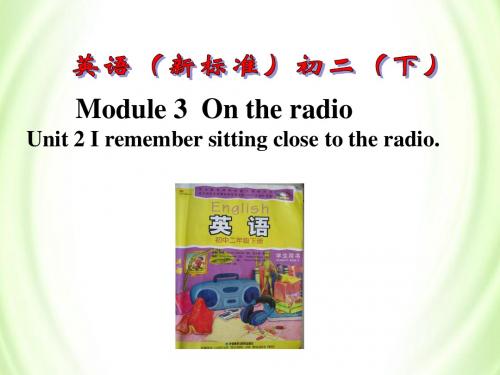
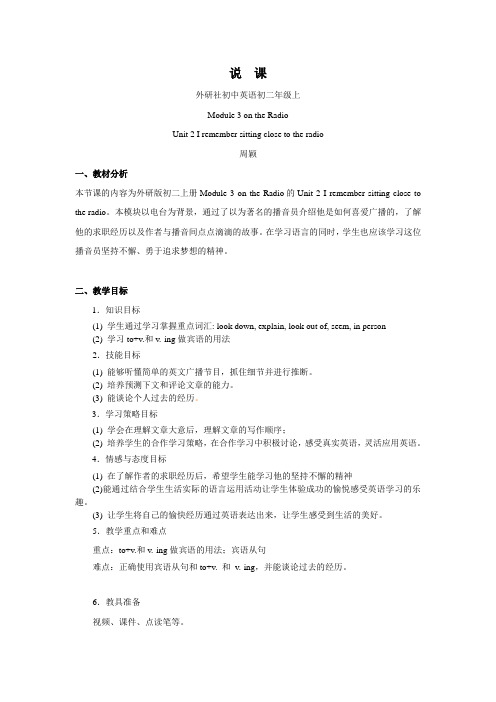
说课外研社初中英语初二年级上Module 3 on the RadioUnit 2 I remember sitting close to the radio周颖一、教材分析本节课的内容为外研版初二上册Module 3 on the Radio的Unit 2 I remember sitting close to the radio。
本模块以电台为背景,通过了以为著名的播音员介绍他是如何喜爱广播的,了解他的求职经历以及作者与播音间点点滴滴的故事。
在学习语言的同时,学生也应该学习这位播音员坚持不懈、勇于追求梦想的精神。
二、教学目标1.知识目标(1) 学生通过学习掌握重点词汇: look down, explain, look out of, seem, in person(2) 学习to+v.和v.-ing做宾语的用法2.技能目标(1) 能够听懂简单的英文广播节目,抓住细节并进行推断。
(2) 培养预测下文和评论文章的能力。
(3) 能谈论个人过去的经历。
3.学习策略目标(1) 学会在理解文章大意后,理解文章的写作顺序;(2) 培养学生的合作学习策略,在合作学习中积极讨论,感受真实英语,灵活应用英语。
4.情感与态度目标(1) 在了解作者的求职经历后,希望学生能学习他的坚持不懈的精神(2)能通过结合学生生活实际的语言运用活动让学生体验成功的愉悦感受英语学习的乐趣。
(3) 让学生将自己的愉快经历通过英语表达出来,让学生感受到生活的美好。
5.教学重点和难点重点:to+v.和v.-ing做宾语的用法;宾语从句难点:正确使用宾语从句和to+v. 和v.-ing,并能谈论过去的经历。
6.教具准备视频、课件、点读笔等。
三、教学设计八年级的学生已Module2中学习了宾语从句,在上学期也接触过v+ing形式经过近一年半的学习,学生在掌握了一定的语言基础和词汇量的基础上,也掌握了一些阅读方法和策略,如抓住所材料的主要信息,对所阅读信息进行推断。
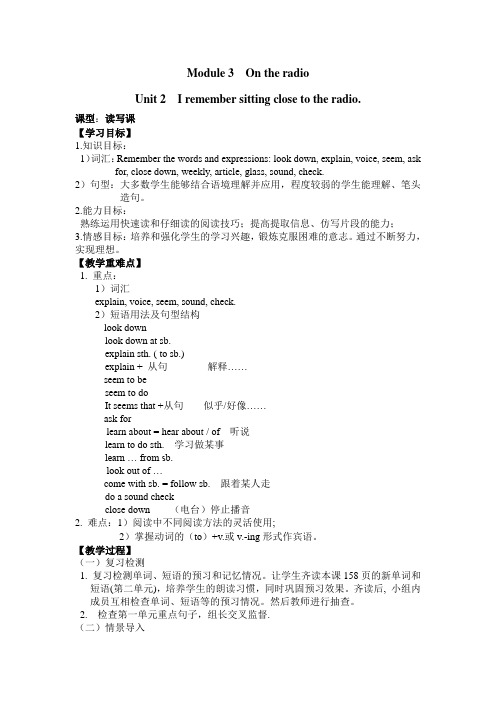
Module 3 On the radioUnit 2 I remember sitting close to the radio.课型:读写课【学习目标】1.知识目标:1)词汇:Remember the words and expressions: look down, explain, voice, seem, ask for, close down, weekly, article, glass, sound, check.2)句型:大多数学生能够结合语境理解并应用,程度较弱的学生能理解、笔头造句。
2.能力目标:熟练运用快速读和仔细读的阅读技巧;提高提取信息、仿写片段的能力;3.情感目标:培养和强化学生的学习兴趣,锻炼克服困难的意志。
通过不断努力,实现理想。
【教学重难点】1. 重点:1)词汇explain, voice, seem, sound, check.2)短语用法及句型结构look downlook down at sb.explain sth. ( to sb.)explain + 从句解释……seem to beseem to doIt seems that +从句似乎/好像……ask forlearn about = hear about / of 听说learn to do sth. 学习做某事learn … from sb.look out of …come with sb. = follow sb. 跟着某人走do a sound checkclose down (电台)停止播音2. 难点:1)阅读中不同阅读方法的灵活使用;2)掌握动词的(to)+v.或v.-ing形式作宾语。
【教学过程】(一)复习检测1. 复习检测单词、短语的预习和记忆情况。
让学生齐读本课158页的新单词和短语(第二单元),培养学生的朗读习惯,同时巩固预习效果。
齐读后, 小组内成员互相检查单词、短语等的预习情况。
Module 3 On the radio一. 教学内容:Module 3 On the radio二重点内容:动词不定式与动名词作宾语三. 具体内容:语法知识详解:动词不定式与动名词(to+v.与 v.+ing)作宾语,非谓语动词中只有动词不定式和动词的-ing形式可以做宾语。
1. 作宾语的区别(1)like,love之后接v.ing 形式、不定式均可,且意义差别不大。
用动词-ing形式强调一般的行为习惯、爱好,用动词不定式强调具体的某次动作。
eg.I like singing, but I don’t like to sing today.我喜欢唱歌,可是今天不想唱。
(2)begin,start之后接动词-ing形式、不定式均可。
eg.Let’s begin singing(to sing).我们开始唱歌吧。
但是当begin,start本身是-ing形式或跟feel,know, understand等表示心理的动词连用时,常用不定式作宾语。
eg.I’m beginning to feel hungry.我开始觉得饿了。
(3)forget, remember, stop. Go on 等之后接形式和不定式意义差别较大。
Stop to do sth.停止做一件事去做另一件事Stop doing sth.停止正在做的事Remember to do sth.记得去做某事Remember doing sth.记得做过某事Forget to do sth. 忘记去做某事Forget doing sth. 忘记已做了某事Regret to do sth.遗憾要去做某事Regret doing sth. 后悔做了某事Mean to do sth. 打算做某事Mean doing sth. 意味着做某事Try to do sth. 努力去做某事Try doing sth. 试着作某事Go on to do sth. 继续去做另一件事Go on doning sth. 继续做同一件事(4)agree,decide,hope,learn,wish,would like之后只接不定式作宾语,不用形式。
Module3 On the radio Unit2 I remember sitting close to the radio
【Teaching type】Reading and writing
【Analysis】The reading passage of this unit is about something about Radio Times.
It tells us a story about a little boy who likes a job in radio. After reading the passage ,maybe more and more students will love the job in radio.
【Teaching Aims】
To understand the reading passage.
To learn some important vocabulary about radio.
To grasp some important structures with verbs followed by –ing.
To practice Ss’ reading and writing skills
【Important and difficult points】
To practice Ss’ reading skills of the topic: On the radio.
To improve the Ss’ writing ability.
【Feelings and Attitude】
To make the students love their jobs in the future.
【Methods】
1.With enough vocabulary support and pre-reading activity, students should read the text again and again and try
to understand the text thoroughly
2. To retell the text with the help of some key words.
【Teaching steps】
Step1: Revision and lead-in
Teacher’s Activity:
1. Do some revision. Ask some of the students to have a dialogue.
2.Ask: What do you want to be when you grow up? Do you want to have a job in radio?(Ss may say“Y es”)
Do you want to know a radio presenter’s job? Now let’s learn the text.First, let’s deal with Activity1:Look at the picture and say what it shows.(Let Ss look at the picture carefully and discuss what they can see.)
Then check the answers.
Students’ Activity:
1. Look at the picture carefully and give their answers. If they have any
difficulties, they may have a discussion with their classmates.
2.Answer the teacher’s question.
3.Do the Ex in plete the passage with the correct form of the words in the box in Activity1then check the answers.
Step2:Reading
Teacher’s Activity:
1. Ask students to read the text with the three questions:
2. Check the answers.
3. Ask Ss to read the text more carefully and do Ex in Activity3.
4.Ask Ss to retell the text according to some key words.
Step3:V ocabulary learning
Teacher’s Activity::
1. Ask students to read the words aloud.
2. Ask students to underline the words in the text, and then try to figure out the meaning according to the context.
3. Group the Ss to check their meanings.
4. Ask the Ss to do the Ex in Activity4: Answer the questions about the words and expressions in the box.
1) Why does the writer ask“ How could I explain?”
2)Did the writer write all the articles on his home page in person or did someone help him?
3) How did the writer prepare programmes about the weather?
Step4:Writing
Teacher’s Activity::
1. Deal with Activity5:First, ask Ss to look at the sentences from the passage in the two squares and
distinguish them between events in the past and background information .
2. Ask Ss to find more sentences which show:
1) more about the important event in the past
2) background information.
3.Deal with Activity6:Make the Ss think of something they love doing, and imagine they have had a job doing it. Write a passage describing an important event in the past, and some background information.
Students’ Activity:
1.Read and distinguish the sentences.
2. Find more sentences from the text.
3. Write the passage in class.
Step5:Learning to learn
Step6:Do Ex12 in the workbook in class: Write a short introduction to a radio show for your school about Bernard Longmore.
Homework: 1.Do the rest of the Ex in the workbook. 2.Prepare for unit3.
Blackboard Acti vities:
Postscript:。